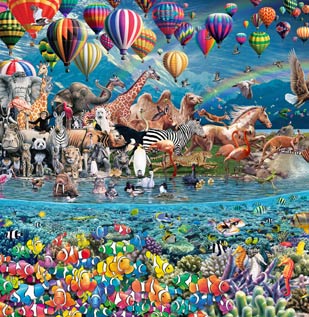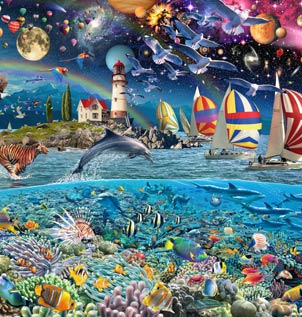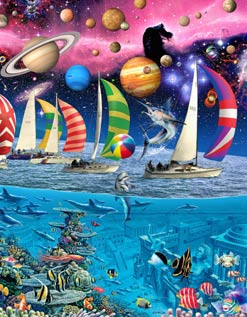|
LIFE: The Great Challenge - by Royce B. McClure
|
TIPS:
BEGINNING THE CHALLENGE:
After buying the puzzle and before assembling it, the first thing you need to decide is are you are going to keep the four bags of puzzle pieces separate and complete the puzzle in four 6,000 piece sections. Or are you going to mix the four bags together and assemble the image as one 24,000 piece puzzle.
Doing it in sections is still a sizable challenge, it will take commitment. So do ponder on it for a while. If it is going to be made as one puzzle then it is imperative that you do some planning and organizing. The completed puzzle measures 4.28m x 1.57m (approx 14ft x 5ft 2in) and so you are going to need a flat surface of sufficient size to assemble it on. Also you are going to need additional space to layout the unassembled pieces for viewing and selection. This factor alone might mean that it's best that you do it in 4 parts.
If you wish to be entered in our Hall of Fame under the '24,000 piece puzzle' category we'd like you to film mixing the bags together or take a series of photos showing it happening. If you have already started and didn't do this then ensure you take plenty of 'in progress' photos of the puzzle as it is being built as this will show us that the bags were pre-mixed. If you are aiming to be in one of our 'speed' Hall of Fame categories you may need to be logging dates and time etc.
ASSEMBLY SPACE:
Again, the completed puzzle measures 4.28m x 1.57m (approx 14ft x 5ft 2in) and so most people would not be able to have a dedicated space for this puzzle to stay on display during the assembly of the entire puzzle. Here are some tips that we've been told or have gleaned from the experiences of others that we found posted on the web. The methods described here can be 'scaled' down if the puzzle is being made in four parts - but the same principles apply.
- Use a table tennis table ( won't fit the whole puzzle)
- Use large sheets of plywood, foam core or fluted-core plastic and pop on top of a double/queen or king bed, or folding card or camping tables etc. At the end of the puzzle-making session carefully stack the sheets (with the puzzle pieces still on) And store in the garage, spare room or under a bed. The large plywood sheets can be quite heavy and so the other two options are preferred if they need to be packed away frequently (these sheet can be used later for gluing the completed puzzle onto). Due to the weight of the plywood they don't slide around too much. But if using the foam core some people prefer to add an extra sheet on top to protect the puzzle pieces from sliding off and then clamp the 'pile' together with large bulldog clips or something similar. Extra boards can be used for laying out the yet unassembled pieces.
- Duct tape together large sheets of foam core so that they hinge like a board game playing board. Place this on top of a table or several card tables or a bed etc. Depending upon the arrangement you may need to take care not to place too much weight on the boards as they could tip over. On top of the board spread out a large sheet of thick felt or quilting wadding. Assemble the puzzle or layout the unassembled pieces on this. When it comes time to pack up, carefully roll the fabric around a plastic drain pipe (cut to the right length) and then tie in place.
Some people have slight variations on this theme. Some have the wadding duct taped to the tube. This requires the tube to be supported while the puzzle is being assembled or for there to be extra fabric so that the fabric hangs off the edge of the table/bed so the tube can lay on the floor. By duct taping the fabric to the tube it can be packed away by one person. Otherwise it takes two to carefully roll the puzzle away A good alternative to this would be to put velco along tube and along the edge of the wadding.
Once rolled some people secure it with elastic bands, others with velco, others just tie it in several places.
STARTING THE PUZZLE:
Most people like to build the border first, then work on building up the inside puzzle.
So to do this you need to sort out the straight edges from the bulk of the pieces. If you are mixing all the bags then this is quite a lengthy task. It's wise to do some other pre-sorting at this stage too. So while you are taking out the edges also sort the 'inside' pieces into main color groups. Putting then into empty ice cream containers ( good because they have tight fitting lids and can be stacked - but other variations that have been used: buckets that are stacked inside each other at 'tidy up' time with the puzzle pieces still inside the bottom of each, cardboard Chinese takeaway boxes, rectangular clear take out food containers with lids, large plastic ziplock bags )
When sorting the edges -set aside separately the 4 corners when you come across them.
Build from the corners whenever possible, joining strings of pieces together. And matching the puzzle to the image on the poster/box lid.
BUILDING THE CENTER OF THE PUZZLE:
The best way to build the interior is to take small easily identifiable portions and build them. In this case it could be the hot air balloons, the light house, the yachts, a planet or specific animals etc. It doesn't much matter which as long as there are distinct colors than mean it's easy to select which pieces are part of it..
Position the completed sections inside the border using the poster/box lid as a guide for position.
Another favorite of mine is to build the words. On this puzzle it would be the artist's signature and the names and numbers on the boats. I keep an eye out for these special pieces when I'm sorting for straight edges and this means that I can then have something easy and fast to assemble for the interior of the puzzle.
With key areas assembled now look for large areas of the picture where there are pieces of distinct texture or an exact color such as the purple nebula, the rainbow, the sea, the line where the sky and sea meet etc.
Once you have significant areas of the puzzle built you can then use the puzzle piece shape to help you assemble larges areas where texture or color are similar. With careful observation you can see that there is a definite pattern to the puzzle pieces. And specific intervals the pattern of the puzzle piece layout repeats.
And you will notice that the pieces tend to be taller than they are wide, and so this can help guide you as to which way they could be oriented.
Click HERE for tips on displaying the completed puzzle.
|
|
|
|







